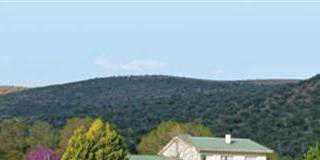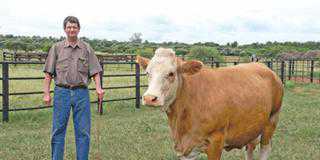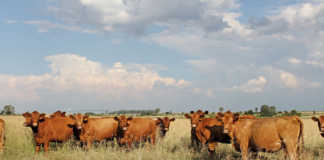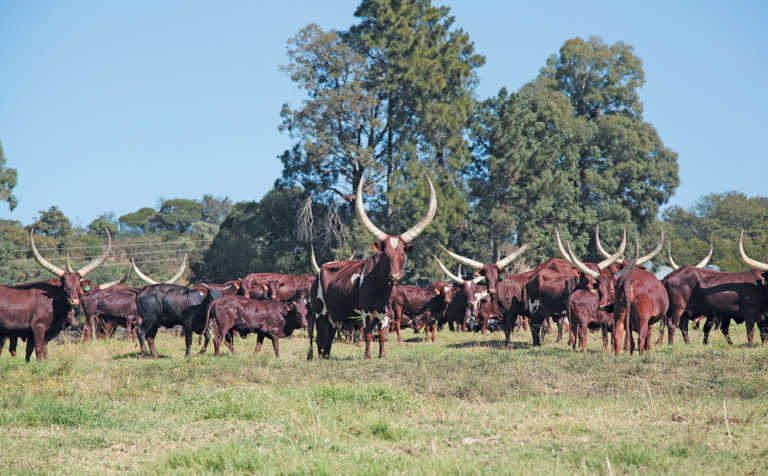
Photo: Gerhard Uys
Ankole cattle, with their iconic, sweeping horns, are a breed that very few people in this country have ever encountered. So, for the South African visitor to Ntaba Nyoni farm near eManzana in Mpumalanga, it is remarkable to see an entire herd of these animals.
Ntaba Nyoni is the farm of SA deputy president Cyril Ramaphosa, who also owns a Boran and Bonsmara stud, farms game and runs a feedlot. Ramaphosa became interested in Ankole when he visited Ugandan president, Yoweri Museveni, in 2004.
Museveni offered to sell him some of the cattle, but the Department of Agriculture, Forestry & Fisheries prevented the importation, citing inadequate disease control measures in Uganda.
Determined to solve the problem, Ramaphosa began by enlisting the assistance of Dr Morné de la Rey, a vet and director of Embryo Plus, who has been extensively involved in embryo transfer, especially in Boran cattle. He then purchased 43 Ankole cows from Museveni and shipped them to Ol Pejeta in Kenya, where Embryo Plus runs an embryo quarantine station.
The cows were artificially inseminated, and the embryos flushed after seven days and sent to South Africa. Here they were transferred to cows, which were then quarantined for two months. Today, there are approximately 100 Ankole breeding cows on Ntaba Nyoni.
Adaptability
The geology of the eManzana area consists of mountainous sandstone formations, resulting in mainly sandy soils and hence sourveld vegetation. The high rainfall of about 900mm/ year and consequent leaching means that grasses reach a post-climax, or unpalatable, stage fairly quickly.
Eragrostis-type grasses abound, and E. curvula is planted as pasture for use in the feedlot during grazing shortages in winter. There is a small component of red grass (Themeda triandra).
READ Cyril Ramaphosa’s Ankole bull sells for R640 000
According to Kobus Rall, animal scientist and general manager of the farm, the area is a harsh environment in which to breed cattle. However, Ankole cattle are not selective grazers, and as the breed originated in Uganda where there is often low quality grazing, Ramaphosa’s animals adapted quickly to the eManzana area.
“You can see it when you look at their condition on the veld. Even during the drought we simply provided a production lick, with 28% protein, as supplement,” says Rall.
The hardiness and adaptability of the Ankole became apparent only after they arrived on the farm, Ramaphosa explains. In normal rainfall years, a mineral lick is provided in summer, and a 50% protein lick is given in winter.
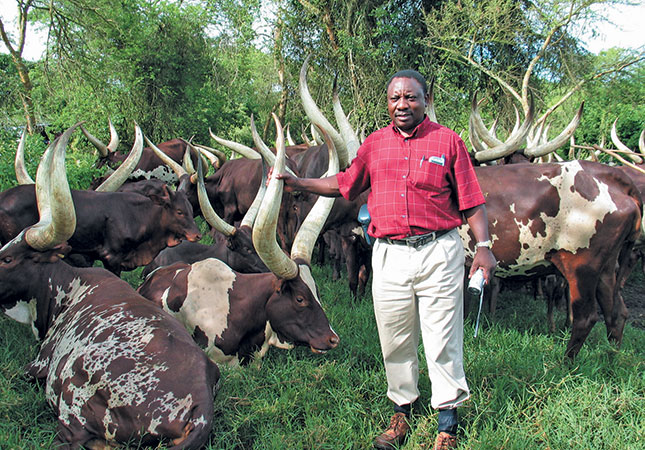
According to Rall, the eManzana area has an extremely high tick-load throughout the year; a standing joke in the area is that ticks originated here. As temperatures do not fall as low as on the Highveld, the tick-load is also high in winter. The Ankole, however, is more tick-resistant than other breeds as a result of natural selection in Uganda’s very harsh conditions.
Moreover, farmers in that country cannot afford to dip their animals.
“Where our Borans and Bonsmaras are dipped fortnightly, the Ankoles are dipped only every three weeks. This means animals are handled less and are thus less stressed. The farm has never lost an Ankole to a tick-borne disease,” Ramaphosa says.
As the Ankoles are stud animals, vaccination against anthrax, black quarter, botulism, brucellosis, lumpy skin disease, and bovine viral diarrhoea is standard.
Grazing management
The Ankoles are grazed in a high-density grazing (HDG) system in large camps of between 100ha and 150ha in size. Rall explains that he does not adhere to a specific stocking density, preferring to monitor the available grass reserves before moving the cattle.
The main criterion is that both palatable and unpalatable grasses should be grazed down to the same height. Hard grazing and long periods of rest are thus required.
If too few stud animals are available to apply HDG, weaner calves from the feedlot that need backgrounding are grazed alongside them.
According to Rall, the main aim of HDG is to give palatable grass species a competitive advantage. Red grass, in particular, does well under HDG, especially when camps are burnt every third to fourth year.
Breeding programme
“At the moment, we’re focusing on breeding numbers and saving the breed by using embryo transfer as well as regular breeding,” Rall explains. “In Uganda, there’s a big drive towards crossbreeding, and some say that if crossbreeding continues at this rate, the breed will disappear in 40 years. We don’t simply want to increase numbers for the sake of it, but approach it scientifically and use fertility as a selection criterion.”
“In Uganda, there’s a big drive towards crossbreeding, and some say that if crossbreeding continues at this rate, the breed will disappear in 40 years. We don’t simply want to increase numbers for the sake of it, but approach it scientifically and use fertility as a selection criterion.”
READ Three-way crossbreeding for optimal production
Unfortunately, Ankoles reach puberty late and heifers are put to the bull only at 30 months. “We’re trying to shorten that period through good management and correct feeding practices.”
The oldest cow in the herd was born in 2006, and is still in production, an indication of the Ankole’s longevity.
An 80% calving percentage is maintained, with a 365-day (or shorter) intercalving period.
“Fertility is measured through conception and preconception. The birthweight is so low [on average 20kg, compared with 40kg in other breeds] that we need to focus on weight gain. We try to have the heifers gain 0,9kg/ day from birth and weaning. This means a 205kg weaning weight,” Rall explains.
Bulls weigh 500kg to 700kg, and cows between 400kg and 500kg.
In the medium-term, the aim is simply to increase the size of the herd; stricter selection criteria will be applied in future, with fertility and horn size taking precedence.
“Horn size is important. One will automatically select for length and form, but this can’t happen without fertility. We need balanced, healthy and fertile cattle,” Rall says.
The market: game farm and beef potential
At the first-ever sale of the breed in Ermelo earlier this year, interest in the Ankoles came mostly from game breeders. This is confirmed by Ramaphosa, who says that game breeders value horn size and structure. The Ankole are also highly adaptable, making them suitable for the harsh conditions often prevalent on game farms.
In addition, the breed is attractive for the ecotourism industry, as the Ankole and wildlife can roam together.
But according to Ramaphosa, the Ankole may also be able to play a significant role in the local beef market, especially when climate change is taken into consideration.
READ Following the spoor: What to look for
“The Ankole appeals to beef producers, as well as game farmers,” he says.
“Firstly, those who want to breed pure Ankoles for their meat, which is low in cholesterol, and [secondly] those who want to crossbreed for attributes such as disease resistance.”
According to Dr Morné de la Rey, laboratory tests on Ankole meat have found that it is low in cholesterol and high in polyunsaturated fatty acids as well as omega-3 fatty acids.
The future of the breed in SA
According to Ramaphosa, a constitution is already in place for an Ankole breeders’ association, and will soon be formalised. As this is an indigenous African breed, it
was felt that it should fall under the auspices of the Afrikaner Cattle Breeders’ Society of SA until an association was in place.
“We wanted a repository for good record-keeping,” he says.
Email Kobus Rall at [email protected], or Dr Morné de la Rey at [email protected].











